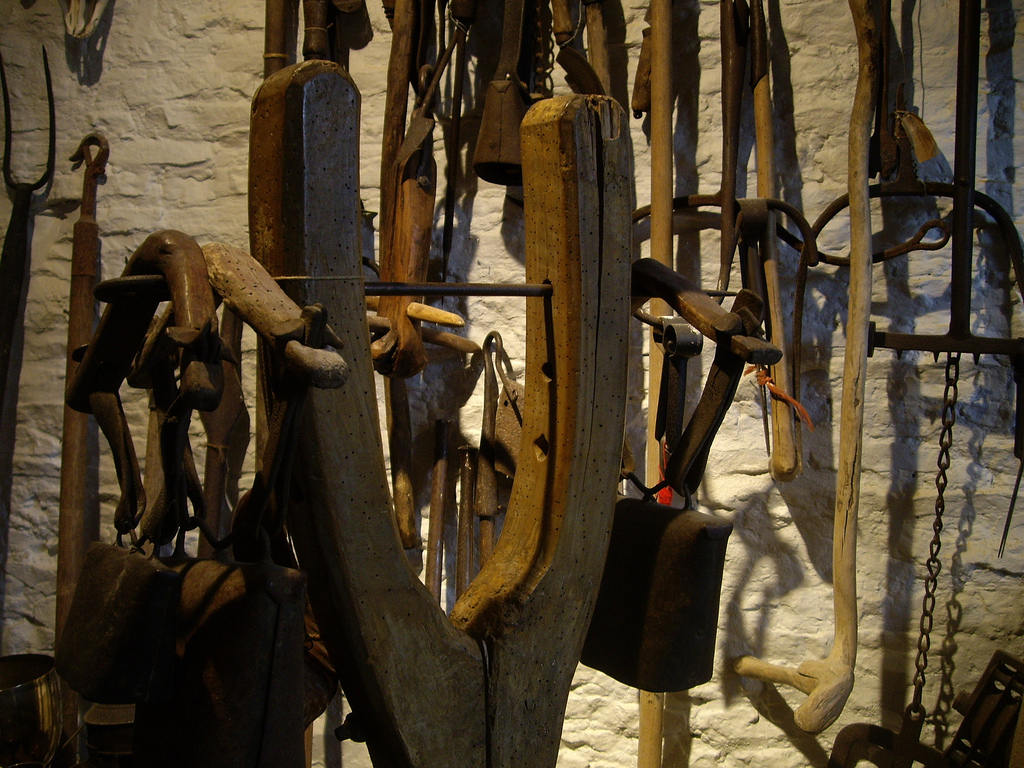This evening’s sheep-related tale comes from Richard Martin at Filkin’s Mill in the Cotswolds. According to Alan Butler*, “the name Cotswold is a combination of ‘Cot’ from the cots or enclosures where the sheep were kept, and ‘wolds’, which is a descriptive word for open, hilly ground.”
In Filkin’s Mill, Richard has collected a vast number of sheep-related materials; a library of things, if you will, to do with the history of sheep and shepherding. One of the items in his collection is a sheep yoke. I recorded Richard discussing this object for one of my Knit Weekly radio features, produced for BBC Oxford. You can listen to that interview here: below is a transcription of the interview.
Cotswold sheep were known as the Cotswold lions; and they used to paint the sheep with ochre, so that – in the market – they would stand out as being these sort of orange/yellow/ochre-coloured lions. And I have a yoke downstairs – because Cotswold sheep are so big, you can’t turn them on their backs very easily to cut their feet – so they used to let them stand on four-square, and they used to put their head inside a sort of wooden yoke, and then a rod across the top of the back of their head, to hold them while they tended their feet. Now the interesting thing about this yoke is it was owned by a man called Garn, of Aldsworth just in Gloucestershire, and his flock (the Garnes were keeping Cotswold sheep for hundreds of years) – HIS flock – was the last flock of Cotswold sheep. And in the late ’60s, there were about 60 sheep left, they were sold at this auction, and from that flock, pretty much all the Cotswold sheep come. If that flock had been lost, and had gone to the abattoir, and not been saved by a group of well-intentioned people, then the Cotswold sheep would have gone. But here’s the interesting thing; if you look on this yoke, you can see – still – traces of yellow ochre, which were put onto the sheep probably at the end of the 18th century. In other words this yoke dates back to the end of the absolute heyday of the Cotswold sheep, when the Cotswold still sheep ruled the countryside. And yet, in 1960, this was at that sale, and – I’m reliably informed – had the sign on it which said “To the TEA-TENT”. In other words this thing links the heyday of the Cotswold sheep at the end of the 18th century with its complete and utter annihiliation (almost) at the end of the ’60s, when the last flock is sold and it’s “To the TEA-TENT”, at the sale. And from that sale, come all the Cotswold sheep that we have left.
Richard Martin – Filkin’s Woollen Mill
I would absolutely love further information on this story; did Cotswold sheep really get down to such incredibly low numbers in the 1960s? Finally, does anyone have a fine photo of a Cotswold sheep so that folk can see what Richard was on about re: their impressive, lion-like size and “Golden Fleece?”
*SHEEP – The remarkable story of the humble animal that built the modern world, by Alan Butler
